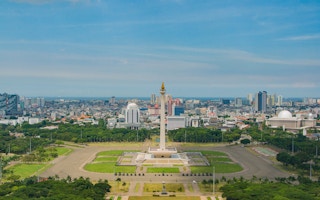Jakarta, the current capital city of Indonesia, whose planned replacement is the proposed Nusantara in East Kalimantan, has experienced massive and rapid changes in its landscapes in the last few decades, mainly caused by increased urbanisation and the expansion of built-up areas. It has become the core area for economic activities where public and private infrastructures were built, but this immense urban development has left one important question regarding sustainability unanswered: Does this kind of urban development pay sufficient attention to the surrounding natural environment?
There has been an assumption within scholarly literature on the Anthropocene (that focuses on a theoretical geological period starting when human activities began to impact Earth’s ecosystems) that there is a huge gap between human beings and nature in the context of urban life. Given rapid physical and social transformation, urban dwellers are no longer in proximity to nature. This is evident in Jakarta, where green areas occupy a small proportion of space in an increasingly concretised city. There is a need to reintegrate public green spaces in Jakarta, enabling balanced urban development amidst the threats of capitalist development.
Increasing public green spaces is a longstanding solution for tackling ever-pressing environmental issues, such as rising temperatures and worsening air pollution. Cities in Southeast Asia are experiencing rising temperatures, especially in the second quarter of 2023. In April, the temperature in Theinzayet, Myanmar, hit 43 degrees Celsius and peaked at 42 degrees Celsius in Bangkok, Thailand. Indonesia’s Meteorology, Climatology, and Geophysics Agency (Badan Meteorologi, Klimatologi, dan Geofisika, BMKG) recorded the recent highest temperature in all of Indonesia at 37.2 degrees Celsius in Ciputat, a district in South Tangerang. Even though this temperature was not as high as that in other Southeast Asian cities, such rising temperatures are a cause for concern for Indonesia, as almost 160 million people (58 per cent) of the population live in cities.
Worsening air pollution has affected lives in the Jakarta greater metropolitan area. As reported in The Jakarta Post, Jakarta’s Air Quality Index (AQI) was at 157 in June, effectively within the “unhealthy” category. There are various reasons for worsening air pollution. The massive usage of private vehicles, the rise in industrial activities within a 100-kilometre radius from Jakarta, and habits of urban dwellers such as the burning of garbage, have all contributed to the unhealthy air quality.
Against this backdrop, the local government had kickstarted some new measures, including the electrification of transportation in Jakarta. This included promoting a shift from motorised vehicles to electric vehicles (EVs). While this could solve some environmental problems in the long run, a more immediate solution is needed to tackle the present problems. Investing in public green spaces is one such measure.
This measure is not new to Jakarta. The local government has already established an urban project creating public green spaces for urban dwellers. The programme for Child-friendly Integrated Public Space (Ruang Publik Terpadu Ramah Anak, RPTRA) was initiated in 2015 to generate public green spaces suitable for children and families living in Jakarta. The main intention was to allow people to use the spaces within RPTRA to do various activities like sports, having gatherings, or simply enjoying the scenery. In the earlier phases, some RPTRAs even set up mini libraries for children to read books and study with their friends. All these provided opportunities for interactions within the local community.
Unfortunately, this initiative was not sustained. Many urban dwellers in Jakarta have revealed that the condition of RPTRAs had worsened over the years. This includes the famous RPTRA Kalijodo, now used by drug dealers and for unpalatable activities like prostitution. Many facilities were not well maintained and had degraded. Approximately 45 RPTRAs, or 14 per cent in Jakarta, are in poor condition.
The degradation of these RPTRAs is a huge waste as these spaces, if properly maintained, can benefit society and the environment. First, RPTRAs increase the connection between nature and urban areas, effectively increasing the green ratio plot (the average ratio of green space per unit ground area) in a region. Second, RPTRAs provide micro-benefits such as replenishing oxygen levels with the presence of trees and developing local ecosystems that aid in improving the overall environment. Moreover, a well-maintained RPTRA can provide beautiful urban scenery and last, RPTRAs can become areas for social cohesion.
“
Instead of relying on high-tech solutions such as the electrification of Jakarta’s transportation modes to resolve environmental problems, it may be more worthwhile to build upon existing low-cost solutions.
The local government should take a more active stand in maintaining these public green spaces. This can provide opportunities for local communities to use these areas for socialising, and in turn, people would have a greater sense of belonging towards their public spaces, perhaps fuelling a higher level of social responsibility to protect and maintain such co-living spaces. Over time, this could increase the involvement of local communities in the management of RPTRAs, thus ensuring its sustainability, unless political reasons adversely affect this project. Besides the costs of maintenance, most importantly, it is crucial to ensure the commitment of the local government to sustain such a project by confirming there is a local budget for public green space preservation. Good monitoring and evaluation by the local government is also needed to guarantee that there will be no misuse of these funds or other corruptive actions.
As much as initiating new measures can help resolve environmental problems, utilising and building on existing measures may be more cost-effective and immediate in bringing benefits to the environment and society. Instead of relying on high-tech solutions such as the electrification of Jakarta’s transportation modes to resolve environmental problems, it may be more worthwhile to build upon existing low-cost solutions. Reincorporating nature into the urban environment through rejuvenating the RPTRAs can thus be the exemplar, since the scheme has already been proven to be efficacious in resolving some urban problems. Once successfully implemented, it can generate ripple effects, possibly spurring new innovations to solve other environmental issues in Jakarta.
Paulus Bagus Sugiyono is a researcher at the Atma Jaya Institute of Public Policy (AJIPP), University of Atma Jaya, Jakarta. Neo Hui Yun Rebecca is a research officer in the Indonesia Studies Programme, ISEAS - Yusof Ishak Institute.
This article was first published in Fulcrum, ISEAS – Yusof Ishak Institute’s blogsite.










